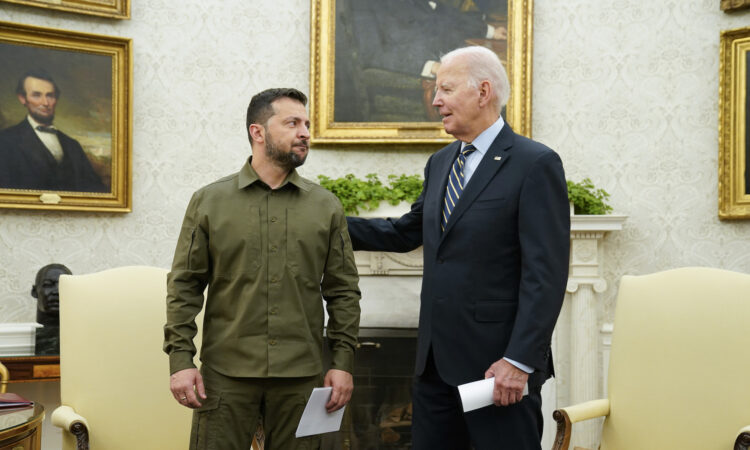
As Congressional Republicans continue to block the latest U.S. aid package for Ukraine, the White House has been clear about the potential fallout. “(Russian President Vladimir) Putin is banking on the United States failing to deliver for Ukraine,” U.S. President Joe Biden warned this week, during a visit to Washington by his Ukrainian counterpart, Volodymyr Zelenskyy. “We must … prove him wrong.”
For its part, the Ukrainian camp has been clear about what the loss of American support would mean: without the money, Ukraine runs a “big risk” of losing the war.
The importance of U.S. aid is obvious. Since Putin launched the war in late February 2022, the U.S. has been Ukraine’s most generous supporter by a wide margin–spending roughly $78 billion on the conflict so far, according to figures compiled by the Kiel Institute, a German think tank.
Germany ranks second, with around $23 billion in support—or less than a third of the U.S. figure. Other countries don’t come close.
So what can Ukraine do, if U.S. aid remains blocked by Congressional infighting? What, in other words, is Zelenskyy’s Plan B for the war?
From Europe, a “big boost”
Part of the answer to that question came Thursday, when the European Union approved the start of formal membership talks with Ukraine — a big boost and show of support for Kyiv even as it struggles to secure additional backing from the U.S.
Another answer came in the form of Zelenskyy’s next stop after Washington this week: an unannounced visit to Norway, which together with Sweden, Denmark, Finland and Iceland, has provided around $12 billion in military and economic aid to Ukraine since the beginning of the war.
In other words, the Ukrainians will now look for money and weaponry wherever they can find it.
The Nordic countries are rich, and they have been strong advocates of the Ukrainian resistance from the beginning. On Wednesday, they pledged to stand with Ukraine for “as long as it takes,” echoing language used by Biden himself. Norway announced its own contribution — disbursements from a five-year $6.8 billion civilian and military package to support Ukraine.
Then came the approval of EU membership talks, at a special two-day summit of European leaders in Brussels which Zelenskyy addressed via video link.
The EU roadmap had been high on the Ukrainian wish list for years; it carries economic benefits and also provides a major symbolic victory, signaling to Russia that Ukraine still has the full-throated backing of its European allies.
Another prize for Ukraine is still being discussed at the Brussels meetings: a package of around $55 billion in European economic aid for Ukraine over the next four years, and additional funding — likely in the range of around $5 billion, according to reports — for arms and ammunition.
The economic aid package is critical for Ukraine to keep its government running through the conflict, and would go towards essentials such as salaries for government workers as the war grinds on. As of late Thursday, EU leaders hadn’t approved either aid package, though hopes were high that they might do so on Friday.
A new strategy
The funding delays and shortfalls are also driving a rethink in Ukraine about the war itself.
Until now, Ukrainian commanders have focused almost exclusively on attacking Russian positions–an aggressive approach that drove Russians back in the early months of the war, but faltered during this summer’s counteroffensive. All along, Ukraine has tried to retake territory and make headline-grabbing advances that might help shore up international support for its resistance campaign.
But as The Messenger reported last week, Ukrainian officials themselves have acknowledged the failings of the counteroffensive, and the drop in money and weaponry from the U.S. will only make things worse.
It’s why the U.S. is now reported to be pushing Ukraine to adopt a more conservative approach, focused on a “hold and build” strategy–as in, holding the territory it controls while it attempts to rebuild its supplies and manpower, according to the New York Times.
Ultimately, U.S. officials told the paper, Ukraine “does not need to claw back all of the nearly 20 percent of the country it has lost to win the war.”
In the meantime, the officials said, the focus should be on smaller symbolic victories–drone attacks inside Russia, for example, or strikes and sabotage operations against naval facilities in Russian-occupied Crimea. These attacks have proved successful in terms of damaging Russian military assets, as well as signaling to the world that Ukraine’s military was making progress.
As Ukraine ponders changes to its strategy, and Congress holds back U.S. aid, two things are clear: Russia isn’t about to change its mind about the war, and the fraying in American support is welcome news in the Kremlin. While the E.U. leaders were gathering in Brussels, Vladimir Putin was delivering his annual address to the nation, a four-hour speech that made abundantly clear that he and his country would not stop the war until Moscow had achieved its “goals.”
“Let’s return to these goals: they have not changed,” the Russian leader said. “I’ll remind you of what we talked about then: the de-Nazification of Ukraine, its de-militarization, its neutral status.”
That statement — and the military might behind it — is one more bit of worrisome news for Ukraine.






